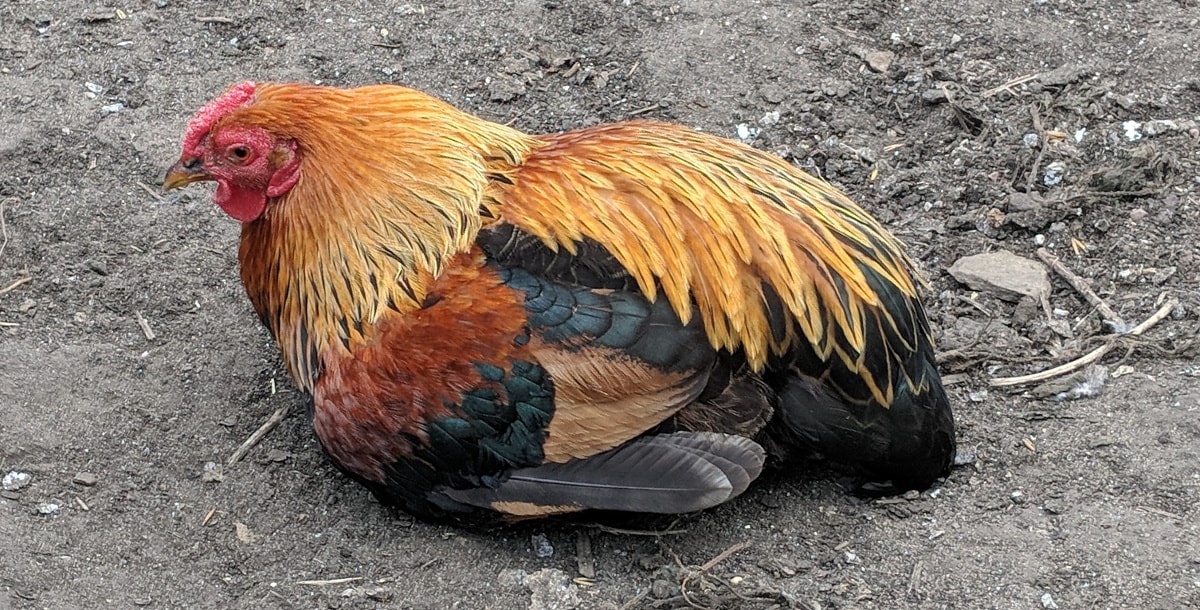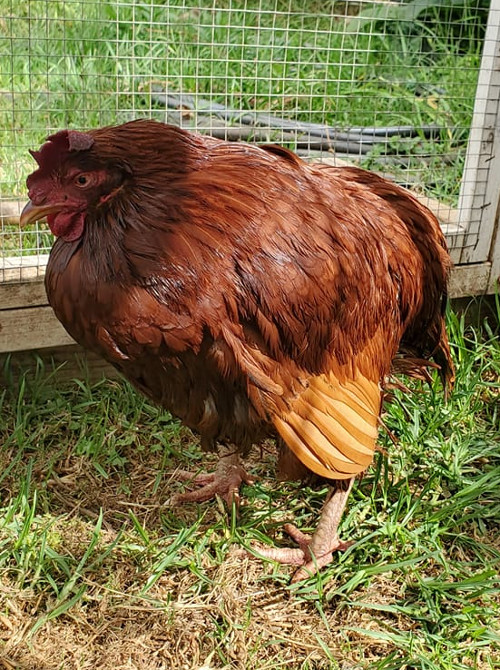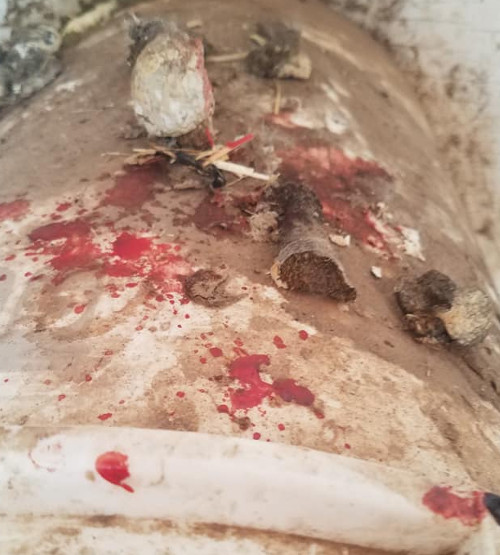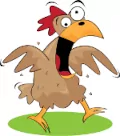How to treat and prevent Coccidiosis in chickens

In the commercial chicken industry Coccidiosis is a disease of young chickens, in backyard flocks it can strike later in life as well.
Table of Contents
Coccidiosis is a common, and sometimes deadly, protozoal disease of chickens caused by a parasite attaching itself to a chicken's intestinal lining. This microscopic organism damages the intestinal tract, preventing the host chicken from absorbing nutrients vital to their survival.
Coccidia symptoms include bloody diarrhoea, watery diarrhoea, ruffled feathers, huddling, weight loss, depression, paleness, lack of appetite and poor weight gain. Some chickens may show no symptoms whatsoever.
It is pronounced kok-si-dee-ow-suhs. It is very painful for the birds and makes them stop eating and hunch over in curved back pose.
While it can affect any chickens of any age, most birds are affected between the ages of 3 and 5 weeks old.
The mean time between infection and the chicken showing symptoms of the disease is between 4 and 7 days. Actual survival time depends on the overall health of the bird and the size of the infected dose received.
Chickens with asymptomatic coccidiosis might live quite a long time but without treatment but most will succumb at some point.
Chickens are mostly immune to coccidia by the time they're 14 weeks old but a bird in poor health or under severe stress may succumb at any age. Certain species infect older birds.
Below: A chicken showing the classic symptoms of coccidiosis.

Understanding Coccidiosis:
Avian coccidiosis is hard to eradicate for two reasons, firstly the oocyst wall is environmentally resistant and secondly, the sporulated oocyst can survive for long time in the environment.
Your veterinarian can diagnose coccidiosis by looking for oocysts or protozoan eggs in a bird's faecal sample under a microscope.
Treatment is important as there is no cross-immunity present between the species of coccidiosis.
You can treat coccidia outbreaks either with medication prescribed by your veterinarian or with anticoccidial medications available at feed stores and from poultry suppliers.
Many chick foods come pre-medicated to prevent coccidiosis outbreaks. When fed to chicks, it helps build the young chicks' immunity to the parasite by allowing some oocysts to make it through.
You can help prevent coccidiosis by eliminating wet litter and use an ammonia-type pine cleaner to disinfect the areas. Keeping the brooder clean will keep coccidia under control.
Below: Coccidiosis is a parasitic disease of the intestinal tract of animals caused by coccidian protozoa. Diagram showing the shape of the sporulated oocyst of Eimeria.

The disease spreads from one animal to another by contact with infected faeces or ingestion of infected tissue. Diarrhoea, which may become bloody in severe cases, is the primary symptom.
There are several different ways the chickens can become infected, the most common is the ingestion of the infective oocyst that is present in the water, feed, and litter.
It is also spread by mechanically by animals, insects, and wild birds that pick the oocyst and spread the disease. The oocyst that is present in the litter and on any premises so can be easily spread by the clothes, shoes, and utensils.
This spread can be easily prevented with proper disinfection of the poultry houses, utensils, and water.
Spread also occurs with the movement of people and equipment between farms.
Under optimal condition oocytes may live for many weeks but it can be rapidly killed under high temperatures and drying. At temperatures of 55°C or below freezing, the oocyst may be killed rapidly.
Infection is less likely during hot, dry weather and greater in cooler, damp weather
The symptoms and signs of coccidiosis in chickens:
One of the first signs of coccidiosis is typically diarrhea, often containing blood or mucus. Affected chickens may also appear lethargic, hunched, and have a decreased appetite. In severe cases, coccidiosis can lead to weight loss, dehydration, and even death, especially in young birds.
Signs of coccidiosis range from:
- Decreased growth rate,
- A high percentage of visibly sick birds,
- Severe or bloody diarrhoea,
- Low feed and water consumption,
- Weight loss,
- Decreased egg production,
- Increased mortality or death.
- Anaemia and pale comb.
Below: Blood in the droppings is a sure sign of coccidiosis.

Below: This hunched immobile position with fluffed feathers is a classic symptom.

Diagnosing coccidiosis:
The diagnosis of coccidiosis is based on a clinical signs and the presence and number of eggs in the droppings, postmortem lesion, and another laboratory tests.
The identification of the species by the size of the oocytes, location of the infection, and type of lesion. These are rapidly confirmed by the presence of eggs in the dropping of the chicken.
The number of oocysts also helps to determine the severity of the infection and has little relationship to some extent of clinical diseases.
The appearance of the flock, rate of morbidity and mortality, rate of feed intake, growth rate, feed conversion ratio and rate of production also help in the diagnosis of coccidiosis.
The typical lesion of E. tenella and E. necatrix are easily evaluated but infection by other species is difficult to identify.
In some cases, mixed infection by more than one species also occurs.
Microscopic examination of the intestinal scraping and dropping for the oocytes. The following sample should be submitted to the laboratory for confirmation of diagnosis.
Litter samples can also be submitted for oocyte count.
Treating coccidiosis:
Treatment of coccidiosis of chickens is with specific anticoccidial drugs and depends upon the severity of the diseases, clinical signs, age, and condition of the birds.
Amprolium is the go to treatment for coccidiosis in backyard flocks of chickens. The dosage of Amprolium in medicated feeds is not strong enough to treat an outbreak. You will need to purchase a stronger solution.
The treatment for the backyard flock chicken keeper is easy: Get some Corid from the feed store or online and follow the directions on the bottle. The product comes in both powder and liquid.
Dose for powder is 1/2 teaspoon per gallon of water for 5 to 7 days. I would treat for longer to make sure you have beaten the disease.
Liquid is 9.5 ml per gallon, same duration of treatment, I would do a week to be safe.
Make the mixture fresh every day and it will control the coccidia and give the hens time to develop immunity.
There are many anticoccidial drugs present in the market for the treatment of coccidiosis of chickens. A full list of treatments is in the table below.
Below: Amprolium 9.6% solution known as Corid for the treatment of coccidiosis in poultry. Availiable to buy or on prescription depending on where you live.

The most popular treatment for coccidiosis is Amprolium, which blocks the parasite's ability to uptake and multiply.
Treatment is usually administered by adding Amprolium to the chickens' water supply, however in some cases, where sick chickens aren't eating or drinking enough, the medication is given orally.
Below: Table showing which coccidiosis drugs are used and their respective egg withdrawal periods.
Drugs
Route of administration
Duration
Withdraw period
Amprolium
Water
1-2 weeks
0
Chlorotetracycline
Feed
3 weeks
0
Oxytetracycline
Feed
5 days
3
Sodium sulfachloropyrazine monohydrate
Water
3 days
4
Sulfadimethoxine
Water
6 days
5
Sulfamethazine
Water
2 days
10
Toltrazuril
Water
2 days
Not applicable
Anticoccidial drugs are used in chick feed as prophylactic medication also occurs for the prevention of the diseases before clinical signs are appearing. These drugs do not stop the complete outbreak.
Treatment is usually given in water.
Antibiotic and increased levels of Vitamin A and K also help to prevent the diseases and improve the rate of recovery.
Continuous use of anticoccidial drugs promotes the emergence of drug-resistant strains of coccidia. For this reason it is advisable to change the medication you treat with if it becomes an ongoing issue with your flock.
You can eat the meat and eggs from a chicken with coccidiosis as most chickens have a residual infection all the time, they are just immune to it. It depends more on the medication you treat the bird with than the infection itself.
Although I would choose not to eat eggs or meat from a sick chicken with coccidiosis there is technically no reason you could not.
Antibiotics do not treat coccidiosis although they are sometimes given with a vitamin and mineral supplement to support recovery and prevent or treat other infections in the birds.
The Coccidia isn't a bacteria, it is a spore forming protozoa, so antibiotics are a waste unless the chicken has a second condition that requires treatment.
Most coccidiosis is species specific and as a rule cannot infect humans. One well-known exception is toxoplasmosis caused by Toxoplasma gondii. Practice good hygiene and wash your hands and do not tempt fate.
Prevention of coccidiosis in poultry:
Prevention of coccidiosis is more important than medication.
To prevent and manage coccidiosis, it's important to practice good hygiene in the coop and run areas. Regularly clean and disinfect the environment, and provide clean, uncontaminated water and feed.
Take the following preventive measures to help keep coccidiosis at bay:
- Dry litter. Adopt a nipple drinking system because it reduces spillage of water onto the litter.
- Proper ventilation system to remove moisture and to keep the litter dry.
- Provide proper feeding and watering space to reduce stress.
- The addition of anticoccidial drugs at the recommended level will prevent clinical infection. Broiler feed must contain anticoccidial agents.
- Adopt a proper vaccination or treatment schedule to enhance immunity.
- Restriction of the movement from one farm to another farm.
- Maintain good hygiene in the shed and regular cleaning.
- Feed and water chickens outside.
- Rotate poultry to new ground.
Life cycle of coccidiosis in poultry:
The life cycle of Eimeria takes about four to seven days to complete. Eimeria species have a direct life cycle, so there is no intermediate host needed to complete the cycle.
Below: The life cycle of the coccidiosis protozoa.

There are different species of Eimeria that cause coccidiosis.
They mostly live and multiply in the intestine cause tissue damage. These are most affected in the rainy season and young birds because the immunity develops after the outbreak of the disease.
There is no cross-immunity present between the species so an outbreak occurs by another species.
Coccidiosis can affect all types of poultry and in all types of facilities.
Coccidiosis causes heavy mortality in young broilers that is reared on deep litter. They are mostly affecting the grower between the age of 3-6 weeks and less than 3 weeks.
It is mostly affected in overcrowding of the chicken in small areas and stress on the bird.
Below: Table showing the different species of coccidiosis and where they infect the intestines.
Species | Site of lesion |
Eimeria acervulina | Duodenal loop |
Eimeria brunette | Lower small intestine |
Eimeria nagani | Lower small intestine and ceca |
Eimeria maxima | Mid- small intestine |
Eimeria mitis | Lower- small intestine |
Eimeria mivati | Duodenal loop to the ceca and cloaca |
Eimeria necatrix | Mid- small intestine |
Eimeria praecox | duodenum |
Eimeria tenella | Cecal pouch |
Prevention of coccidiosis by Vaccination:
When birds are infected with low numbers of Eimeria parasites, protective immunity is developed after two to three consecutive infections.
Live virulent strain is composed of the different number of wild types of strains of virus depending upon the composition and field of application. Coccivac® D, Immucox® C2 are the two products that are used for broiler breeders. In which eight species of Eimeria included. This number is restricted up to four species in the broiler industry (Coccivac® D, Immucox® C2).
These vaccines can be given at the age of 1st week. When these vaccines are used in the chicken the risk of coccidiosis is higher at an early (2-3 weeks) and lower in the age (3-4 weeks) or onward.
See more about protecting your chickens with vaccination.
How do you treat coccidiosis naturally?
You don't treat coccidosis naturally. You should only focus on natural ways to prevent coccidiosis.
Coccidiosis is one of the most endemic, aggressive and expensive parasite diseases in poultry. Natural treatments need to be used a feed supplements and used continuously.
By the time you notice the effects of the coccidia parasite on your flock it will be too late to treat the chickens naturally. You need to resort to a chemical treatment and go back to the natural methods afterwards.
There are no effective organic treatments for coccidiosis that will work in time. Organics like garlic, turmeric, green tea, aloe vera and herbs may have some preventative effects but they will not treat an advanced infection before the bird dies.
Organic treatments are normally feed additives and a sick bird may well have stopped eating. Sorry but letting an animal die a horrible death to be able to stand on some soapbox about being natural just leaves me speechless.
Numerous plant-based products have been found to be effective at treating chicken coccidiosis: Artemisia annua and artemisinin, oregano, garlic, neem, different species of Aloe, green tea, sugar cane, turmeric and many others.
